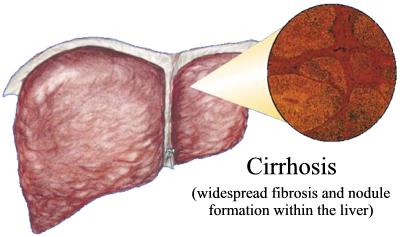
What is Chronic Liver Disease?
What is Chronic Liver Disease?
Chronic liver disease is marked by the gradual destruction of liver tissue over time. Several liver diseases fall under this category, including the following:
cirrhosis of the liver
fibrosis of the liver
What is cirrhosis of the liver?
Cirrhosis is the 12th leading cause of death in the United States, according to the National Institute of Diabetes and Digestive and Kidney Diseases (NIDDK). Because of chronic damage to the liver, scar tissue slowly replaces normal functioning liver tissue, progressively diminishing blood flow through the liver. As the normal liver tissue is lost, nutrients, hormones, drugs, and poisons are not processed effectively by the liver. In addition, protein production and other substances produced by the liver are inhibited.
What are the symptoms of cirrhosis?
Symptoms of cirrhosis vary, depending on severity of the condition. Mild cirrhosis may not exhibit any symptoms at all. The following are the most common symptoms of cirrhosis. However, each individual may experience symptoms differently. Symptoms may include:
abnormal nerve function
ascites – fluid build-up in the abdominal cavity.
breast enlargement in men
coughing up or vomiting blood
curling of fingers (Dupuytren’s contracture of the palms)
gallstones
hair loss
itching
jaundice – yellowing of the skin and eyes.
kidney failure
liver encephalopathy
muscle loss
poor appetite
portal hypertension
redness of palms
salivary gland enlargement in cheeks
shrinking of testes
spider-like veins in the skin
weakness
weight loss
The symptoms of cirrhosis may resemble other medical conditions or problems. Always consult your physician for a diagnosis.
What causes cirrhosis?
The most common cause of cirrhosis is hepatitis c. Other causes include the following:
alcohol
obesity
use of certain drugs
chemical exposure
bile duct obstruction
autoimmune diseases
obstruction of outflow of blood from the liver (i.e., Budd-Chiari syndrome)
heart and blood vessel disturbances
alpha1-antitrypsin deficiency
high blood galactose levels
high blood tyrosine levels at birth
glycogen storage disease
cystic fibrosis
diabetes
malnutrition
hereditary accumulation of too much copper (Wilson’s Disease) or iron (hemochromatosis)
How is cirrhosis diagnosed?
In addition to a complete medical history and physical examination, diagnostic procedures for cirrhosis may include the following:
laboratory tests
liver function tests – a series of special blood tests that can determine if the liver is functioning properly.
liver biopsy – a procedure in which tissue samples from the liver are removed (with a needle or during surgery) from the body for examination under a microscope.
cholangiography – x-ray examination of the bile ducts using an intravenous (IV) dye (contrast).
computed tomography scan (CT or CAT scan) – a diagnostic imaging procedure using a combination of x-rays and computer technology to produce cross-sectional images (often called slices), both horizontally and vertically, of the body. A CT scan shows detailed images of any part of the body, including the bones, muscles, fat, and organs. CT scans are more detailed than general x-rays.
ultrasound (Also called sonography.) – a diagnostic imaging technique, which uses high-frequency sound waves and a computer to create images of blood vessels, tissues, and organs. Ultrasounds are used to view internal organs of the abdomen such as the liver, spleen, and kidneys and to assess blood flow through various vessels.
Treatment for cirrhosis:
Specific treatment for cirrhosis will be determined by your physician based on:
your age, overall health, and medical history
extent of the disease
your tolerance for specific medications, procedures, or therapies
expectations for the course of the disease
your opinion or preference
Cirrhosis is a progressive liver disease, and damage sustained to the liver is irreversible. However, with proper nutrition, avoidance of certain toxins (such as alcohol), vitamin supplementation, and management of cirrhosis complications, further liver damage can often be delayed or stopped. In severe cases of cirrhosis, liver transplantation may be considered.
What is fibrosis?
Fibrosis is the growth of scar tissue due to infection, inflammation, injury, or even healing. The overgrowth of scar tissue can occur in almost any organ. Fibrosis in the liver can inhibit the organ’s proper functioning. Liver fibrosis is usually the result of cirrhosis.